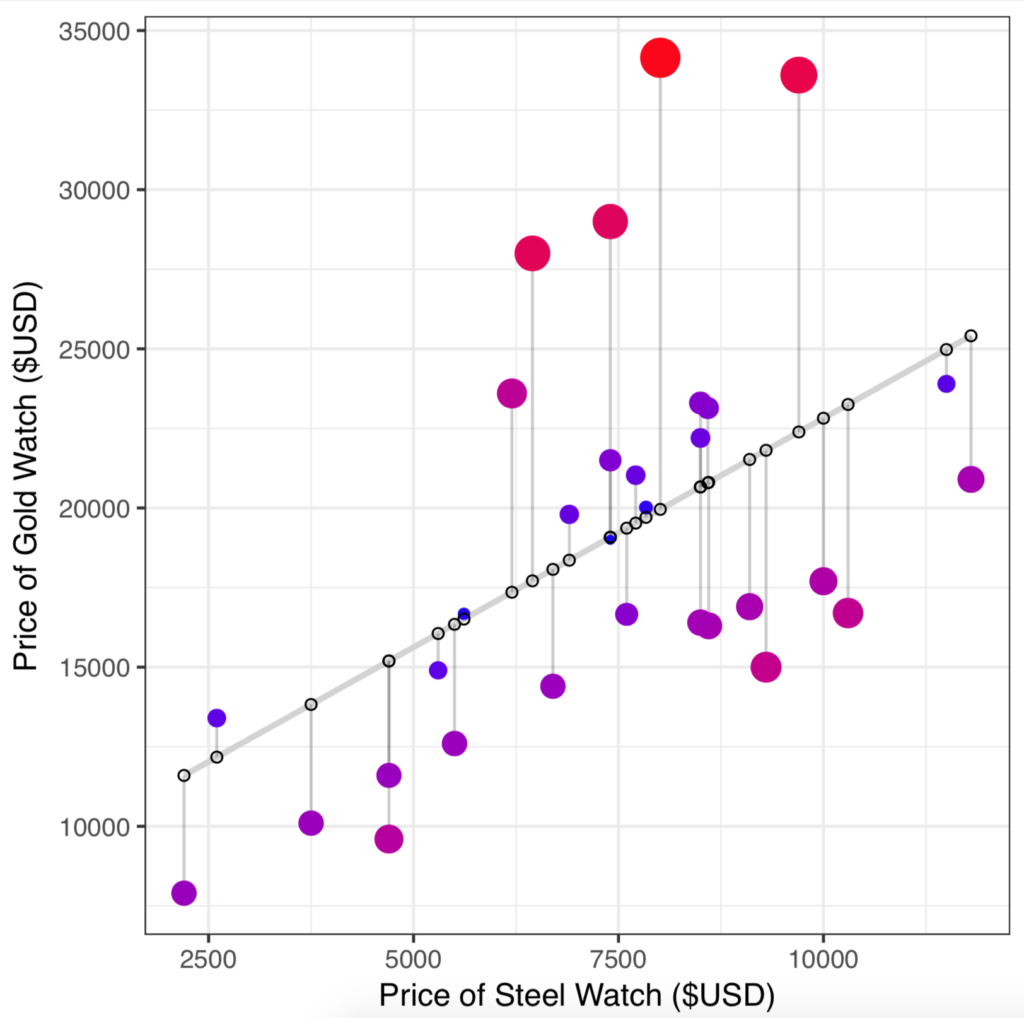
When Grand Seiko introduced its Elegance Collection, aBlogtoWatch’s David Bredan described the pricing structure as “insane.” $7,400 gets you the SBGK005 in a stainless steel case, but the yellow gold SBGK006 will cost you $19,000, while the rose gold costs a mind-numbing $29,000. It’s hard to disagree with David’s assessment, and Ariel Adams and others on the team have railed against exactly this problem. Sure, gold costs more. An ounce of gold is trading for $1,300 and rose gold will cost slightly more, so there’s going to be a premium over the negligible cost of stainless steel. But there’s nowhere near $22k in gold in a watch case, so what exactly is driving the pricing structure of precious metal watches? Is it tooling? Rarity? Exclusivity? Veblen effect? A combination of all these factors? Or perhaps the price is simply what the market will bear — enough people are willing to pay these “insane” premiums, so that’s where the watches are priced. It’s an easy fallback answer and a common sentiment amongst watch enthusiasts, but I wanted to delve a bit deeper and see if I could find a more nuanced explanation. To do so, I spoke to representatives at several large retailers as well as StockX (a “stock market” for things, including watches) and also did a bit of number crunching myself. Lest I bury the lede, my take is that the luxury watch market is doing itself a disservice through illogical (and often astronomical) markups on precious metal watches.
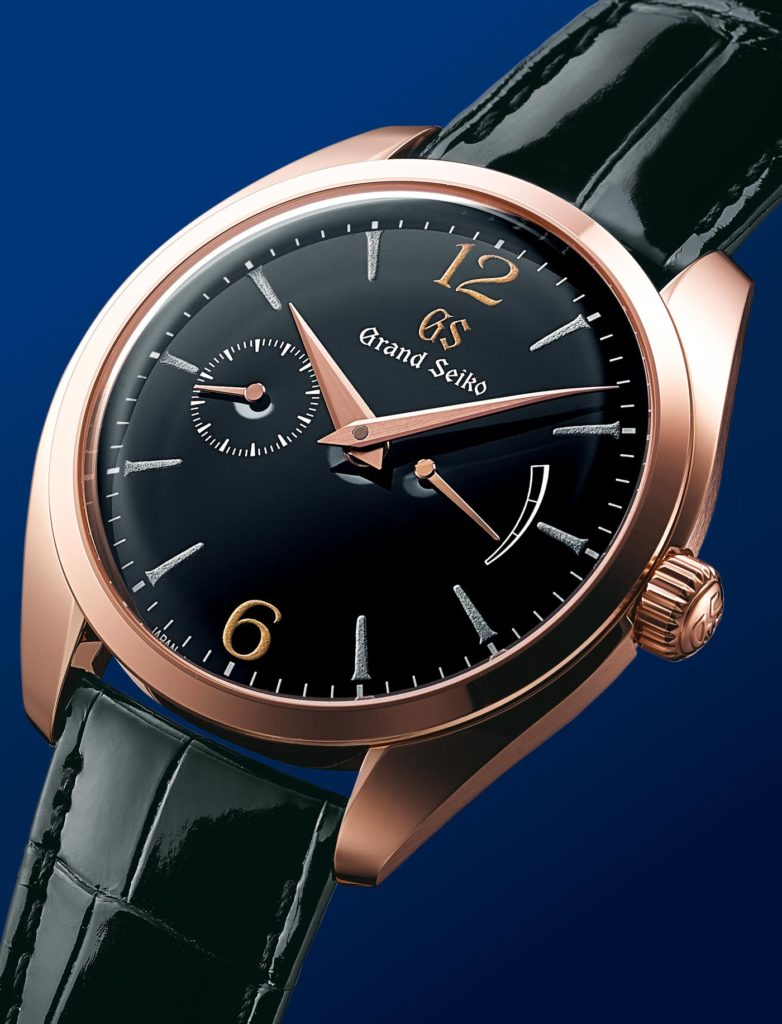
Let’s start by looking at the numbers and see what they reveal about markups on precious metal watches. My background is in science, so I figured the first step should be to dig into the math and throw a bit of science at the problem. To do so, I scoured pricing catalogs to find 30 steel watches from 11 different brands, along with their gold equivalents. (There are 31 points because I included both the rose gold and yellow gold Seikos from the Elegance collection.) Note that there was no overall difference in price or markup between yellow gold and rose gold watches in our sample, so the Seiko is a bit of an anomaly. The steel versions of watches I included ranged from $2,200 to $11,800; I purposefully excluded brands like Patek Phillipe and Audemars Piaget, as a vast majority of their catalogs consist of precious metal watches, and pricing of high-end watches tends to be a whole different ballgame. I only selected watches on straps because bracelet manufacturing and extra material costs are added complications that could bias the data; note also that, primarily for this reason, Rolex watches were excluded. And, of course, Rolex is always the odd exception — the brand for which the normal rules never seem to apply.
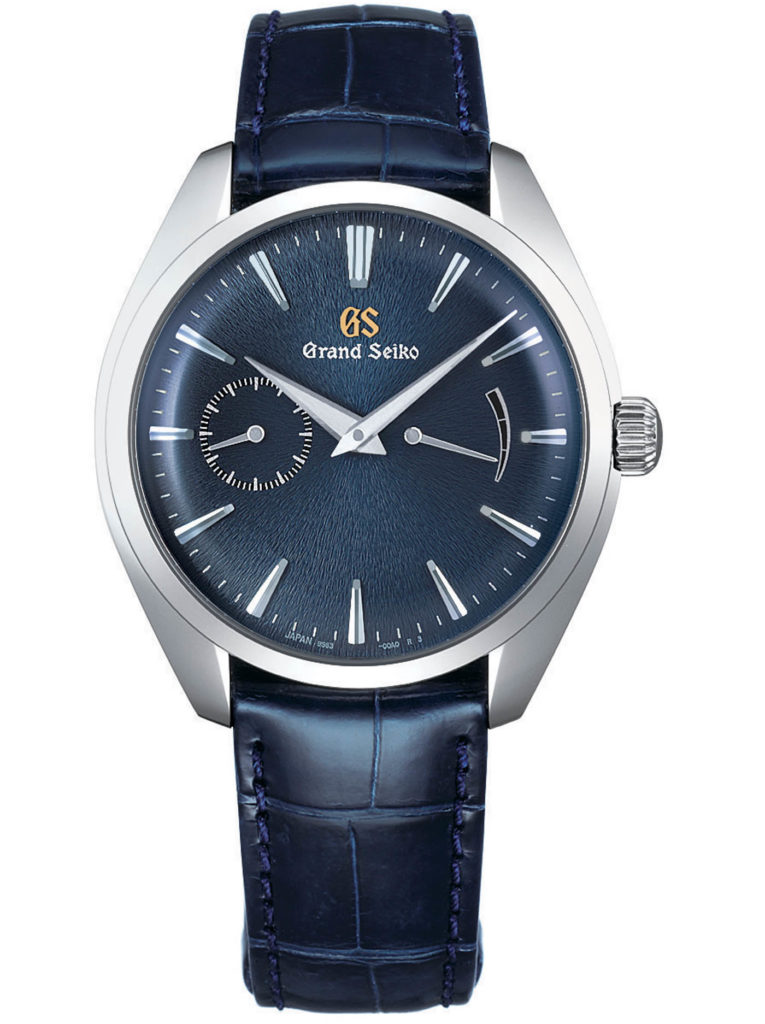
Alright, so now we have some data! The next step is to start asking questions to see what we can learn about the pricing of gold watches. For the sake of the majority of our audience, I’ve left out the nitty-gritty statistics, but if you’re a stats nerd, feel free to ask questions in the comments.
Are markups dependent upon the price of the steel version?
Nope. There is no relationship between the retail price of a steel watch and the amount the gold version is marked up. In other words, if you know the price of a steel watch, it’s nearly impossible to say how much of a premium you should expect to pay for its gold equivalent. The plot below shows what we science types affectionately refer to as a shotgun blast — no pattern whatsoever. Yup, the pricing of gold watches seems to be lacking in the logic department.
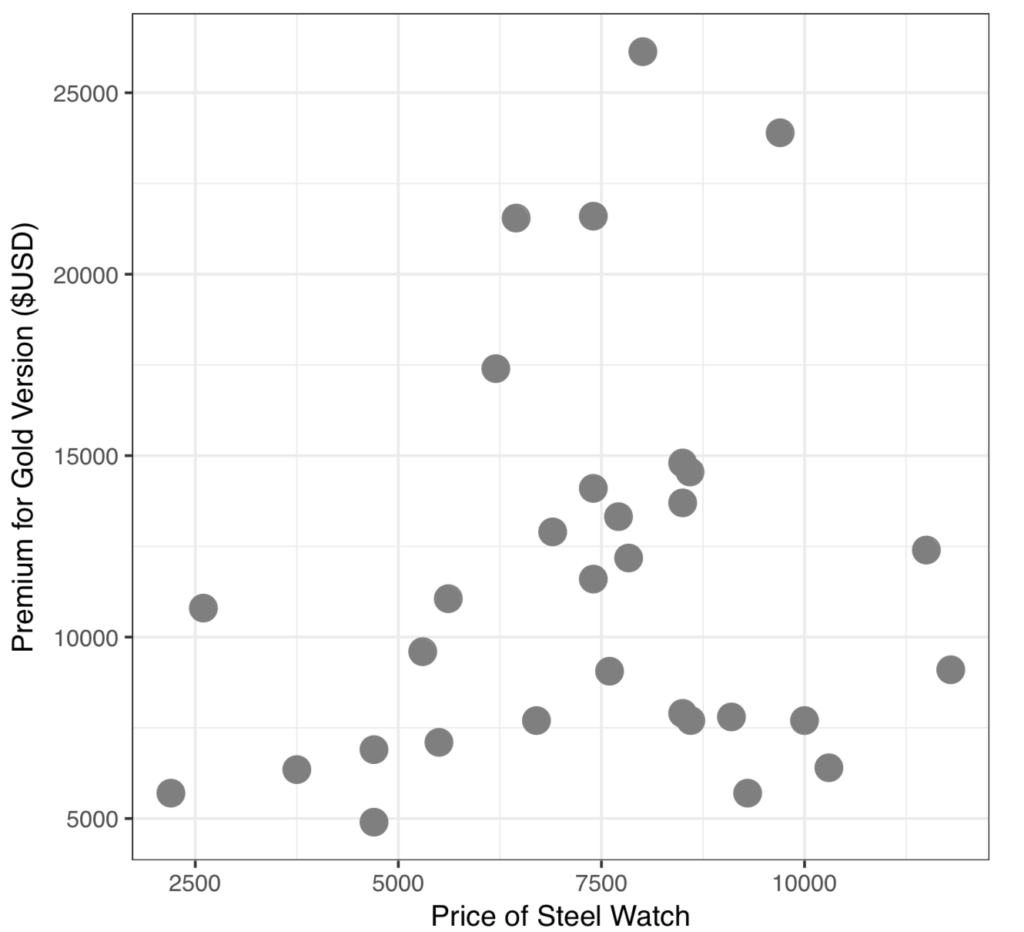
Now, let’s look at the price of a gold watch in relation to the premium you’re paying for the gold version. Here we see that the price of the gold watch depends almost entirely upon how much it’s been marked up. In other words, you’re paying whatever markup is set by the brand, not the intrinsic value of the watch plus a consistent markup across brands. Let’s look at that brand-to-brand variation a bit deeper.
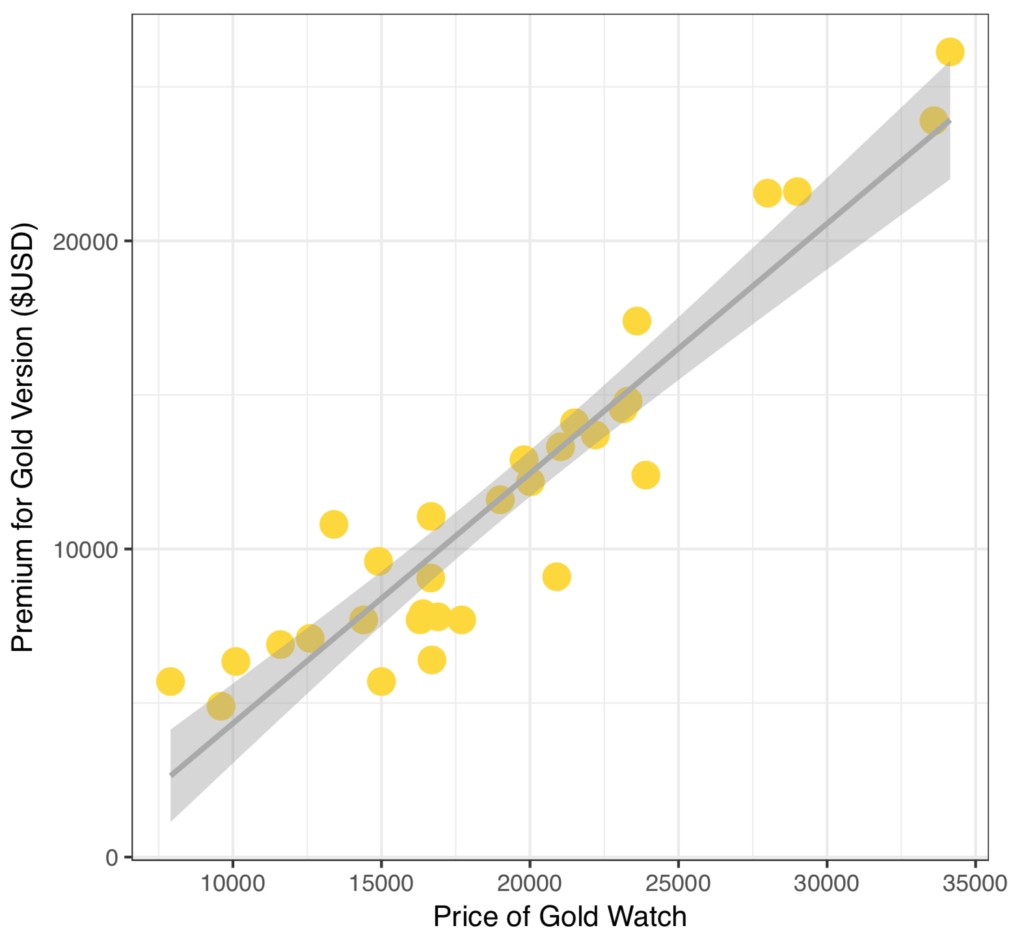
Are pricing markups consistent across brands?
Nope. In the sample of watches I analyzed, markups range from $4,900 to $26,135 and span a moderate 161% increase to a whopping 515% increase in price for a gold version. That’s a lot of variation in premiums. This becomes apparent when we compare the price of a steel watch to the price of its gold counterpart. Here, I’m showing a scatterplot where each point represents a steel watch (price on the x-axis) and its gold equivalent (price on the y-axis). There is a weak positive relationship between the price of the steel and gold watches, but a lot of variation. The gray line is the regression line, which represents the predicted gold price, given the price of the steel version. Deviations from this line are represented by the lollipops — larger, redder lollipops represent greater deviations; those above the line are marked up higher than predicted, those below are marked up lower than predicted. What I get out of it is that watch brands aren’t looking at each other — for that matter, they’re not even looking at other models in their own lineups — when pricing their gold watches. It’s a mad, mad gold-pricing world out there.
What does all this number-crunching really tell us? Mostly, it probably just confirms many people’s suspicions that pricing is all over the map and there’s no clear rhyme or reason to it. At the very least, the pricing structure for gold watches does not seem contingent simply upon material costs, but upon other factors. To figure out what those factors are, I spoke with representatives from several retailers (Govberg Watches, Stephen Silver Fine Jewelry, and Grenon’s of Newport) to see if they could offer insight that the numbers simply can’t provide.
What is ultimately accounting for the premiums?
Frankly, I was surprised by how candid the retailers were when it came to explaining the premiums. All agreed that you’re not paying for intrinsic value (i.e., the value of the gold itself). As Ray Grenon from Grenon’s of Newport said, “Pricing never has to do with the market price [of gold].” And, unless you’re talking about making brand new bracelets, tooling costs are minimal.
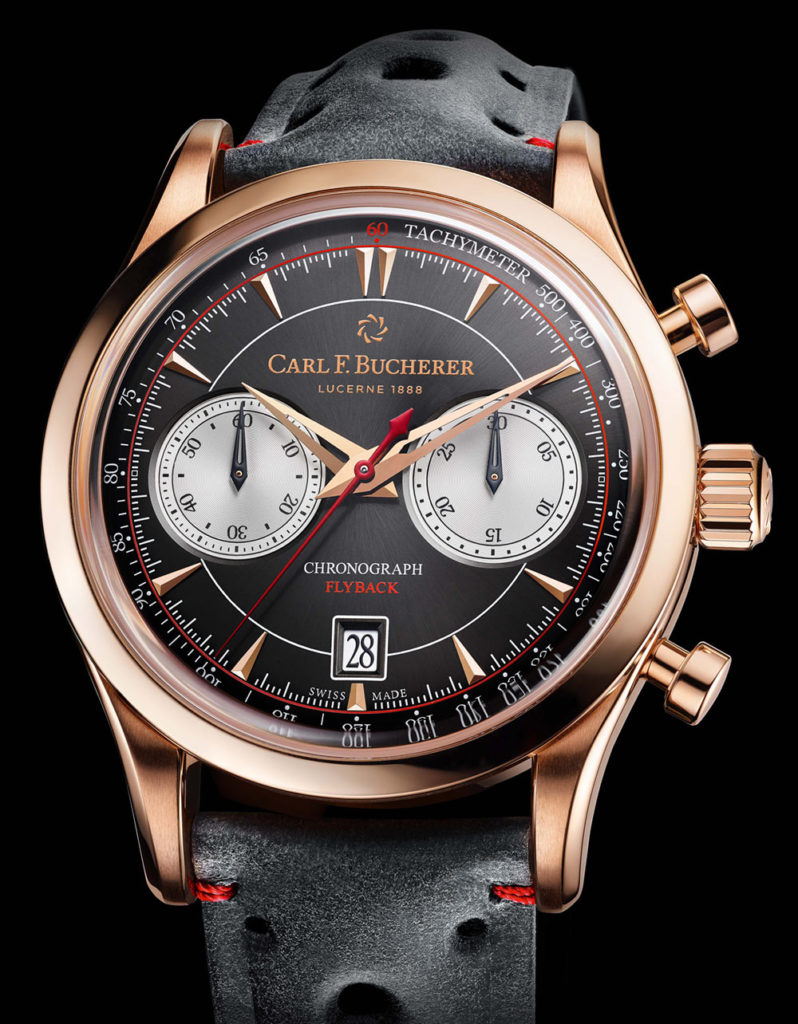
Really, it all comes down to paying for exclusivity. As George Mayer from Govberg told me, “You’re paying for exclusivity, status; you have something others don’t have.” Each retailer echoed this sentiment in one way or another. Whether we’re talking about purchasing gold because of the “perception of value,” as Jared Silver from Stephen Silver Fine Jewelry pointed out, or the “look-at-me effect,” it’s still ultimately about exclusivity.
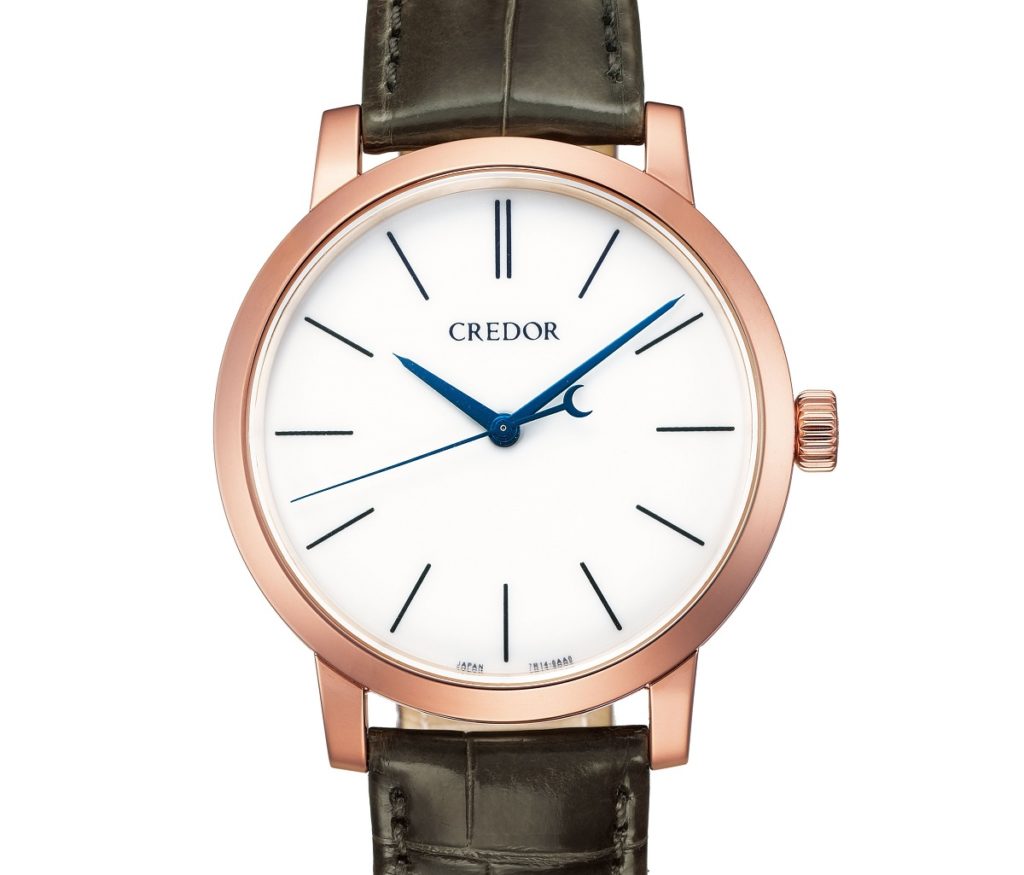
And that’s fair enough. Jared also made a parallel to the car industry: Sure, you can buy the base model, but many opt for the premium model. Even though the upgrades may only cost the car manufacturer several hundred dollars, consumers are willing to pay the extra $10k or more for the sake of buying the premium version. To be fair, there are some functional attributes car buyers gain by upgrading from the base model (heated seats, moon roof, etc.). In the case of watches, not so much. Generally, the only change is the case material, not the movement, finishing, dial, hands, or anything else.
We never said watch collecting was a logical hobby.

